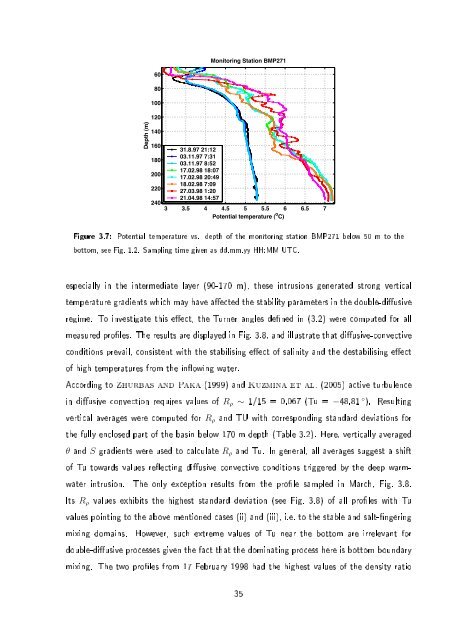Baltic Sea
Baltic Sea
Baltic Sea
You also want an ePaper? Increase the reach of your titles
YUMPU automatically turns print PDFs into web optimized ePapers that Google loves.
Monitoring Station BMP271<br />
60<br />
80<br />
100<br />
120<br />
Depth (m)<br />
140<br />
160<br />
31.8.97 21:12<br />
180<br />
03.11.97 7:31<br />
03.11.97 8:52<br />
200<br />
17.02.98 18:07<br />
17.02.98 20:49<br />
220<br />
18.02.98 7:09<br />
27.03.98 1:20<br />
21.04.98 14:57<br />
240<br />
3 3.5 4 4.5 5 5.5 6 6.5 7<br />
Potential temperature ( o C)<br />
Figure 3.7: Potential temperature vs. depth of the monitoring station BMP271 below 50 m to the<br />
bottom, see Fig. 1.2. Sampling time given as dd.mm.yy HH:MM UTC.<br />
especially in the intermediate layer (90-170 m), these intrusions generated strong vertical<br />
temperature gradients which may have aected the stability parameters in the double-diusive<br />
regime. To investigate this eect, the Turner angles dened in (3.2) were computed for all<br />
measured proles. The results are displayed in Fig. 3.8, and illustrate that diusive-convective<br />
conditions prevail, consistent with the stabilising eect of salinity and the destabilising eect<br />
of high temperatures from the inowing water.<br />
According to Zhurbas and Paka (1999) and Kuzmina et al. (2005) active turbulence<br />
in diusive convection requires values of R ρ ∼ 1/15 = 0.067 (Tu = −48.81 ◦ ). Resulting<br />
vertical averages were computed for R ρ and TU with corresponding standard deviations for<br />
the fully enclosed part of the basin below 170 m depth (Table 3.2). Here, vertically averaged<br />
θ and S gradients were used to calculate R ρ and Tu. In general, all averages suggest a shift<br />
of Tu towards values reecting diusive convective conditions triggered by the deep warmwater<br />
intrusion. The only exception results from the prole sampled in March, Fig. 3.8.<br />
Its R ρ values exhibits the highest standard deviation (see Fig. 3.8) of all proles with Tu<br />
values pointing to the above mentioned cases (ii) and (iii), i.e. to the stable and salt-ngering<br />
mixing domains. However, such extreme values of Tu near the bottom are irrelevant for<br />
double-diusive processes given the fact that the dominating process here is bottom boundary<br />
mixing. The two proles from 17 February 1998 had the highest values of the density ratio<br />
35



